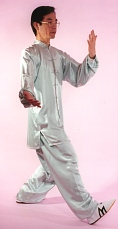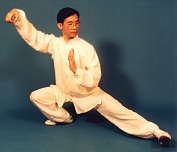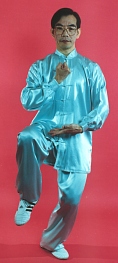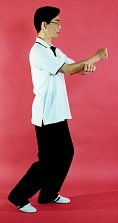The Author:
Dr Paul Lam studies Tai Chi with Professors Men Hui Feng and Kan Gui Xiang of Beijing University of Physical Education for many years. He is a respected teacher, author and family physician. Dr Lam conducts regular workshops in USA, Canada, UK and Australia. He has collaborated with Tai Chi and medical colleagues including Masters Peter Wu, Kam Lau Fung, Ian Etcell and Julie King to write and translate many Tai Chi articles.
How to Get Lucky
I recently found a new meaning for the word ‘luck’. I was chatting to the person next to me on a plane and he told me luck was ‘labour with correct knowledge’. Thinking about it, this can be an appropriate description on how to improve Tai Chi.
Labour means practise (the more the better), without labour you will never get anywhere. Correct knowledge is the correct essential principles, no matter how hard you practise, without the correct knowledge you will get nowhere either.
There are so many styles and different variations within a style that it can be very confusing. There is always someone saying you are doing it wrong, sometimes you might be told that there is only one correct way to do certain thing. Even on well accepted classical texts there are still many different interpretations. I once heard a famous master say "being upright means leaning forward" I am not sure what he meant but he does practise with a obvious forward leaning close to 30 degrees. There are many good books written on Tai Chi knowledge and essential principles, a serious learner should spend a little time with them. In this short article I am going to concentrate on suggested mental approaches that could help you when you are reading these books or learning from different sources.
Internal Art
Tai Chi is an internal art. Being internal has different meanings to many people. To me, one of the most important internal components is the mind. Using your thinking ability and the power of your mind, is one of the most important aspects of being internal. Naturally, other aspects such as developing stronger, softer strength from inside, mind controlling the Qi, and Qi controlling the body are all well accepted meanings of internal.
Use Thinking Power
So how do we find out what the correct knowledge is? Firstly, we need to use our thinking power. Does the idea or the movement make sense? Does it fulfil the martial art principle, the physiological principle? You can use common sense to test out these ideas presented to you. Does it really sound right to you? We can also try it out to see if it feels good. Once you understand the feeling of Qi and can feel the flow of Qi, it can be a very handy guide. Is the movement enhancing the flow of Qi? The correct way will give you a better flow and stronger feel of Qi. Although when learning something new, or changing your usual way of doing things, you tend to feel slightly awkward at the beginning. So when you try new ideas you must bear this in mind and give it a bit of time before you discard the different version.
Be Open-minded
The power of the mind will be a lot stronger if you allow your mind to be opened. Narrow mindedness will do exactly that, gives narrow power. I believe not only are there different ways to do one thing, different people find certain ways suit them better and sometimes different interpretations are like looking at the same object from different angles, it gives us a more complete view. For example, in Yang style, moving forward and backward with feet just above ground, touching down like a cat. Teachers are really happy when they don’t hear the sound of students’feet dragging along the floor. This is effective in training balance, control of gait and transference of weight.
Picture 1. Moving forward Yang style.
On the other hand, with Chen style, you move forward by lightly brushing the
inside of your heel along the floor and follow step by dragging the inside part
of the ball of your foot.
 This
is useful for training stepping forward to position your foot in an attacking
position and using your foot for various self-defence purposes. Sun style flows
like water in a river and we always land lightly. Yet in Chen style, at the
movement of Golden Guard Stamping Ground, we actually stamp our foot down
with considerable force. So Sun style is like a powerful flowing Qigong and the
agile steps are perfectly suitable whereas Chen style, stamping is a way to
shake up the body and mobilise the internal force.
This
is useful for training stepping forward to position your foot in an attacking
position and using your foot for various self-defence purposes. Sun style flows
like water in a river and we always land lightly. Yet in Chen style, at the
movement of Golden Guard Stamping Ground, we actually stamp our foot down
with considerable force. So Sun style is like a powerful flowing Qigong and the
agile steps are perfectly suitable whereas Chen style, stamping is a way to
shake up the body and mobilise the internal force.
Picture 2. Chen style brushing foot forward.
Picture 3. Chen style Golden Guard Stamping Ground.

All these different ways are useful for different purposes and enable us to learn and grow in the broader directions. I believe learning different aspects and techniques from different styles and methods enable us to progress much faster. At any case it would be more interesting than practising one set of forms forever – this is not to say you can develop interest and depth through this way. Different people need different way to progress, by allowing your mind to be opened is the only way you can find out what suit you best.
Picture 4. Sun style stepping forward lightly and follow step.